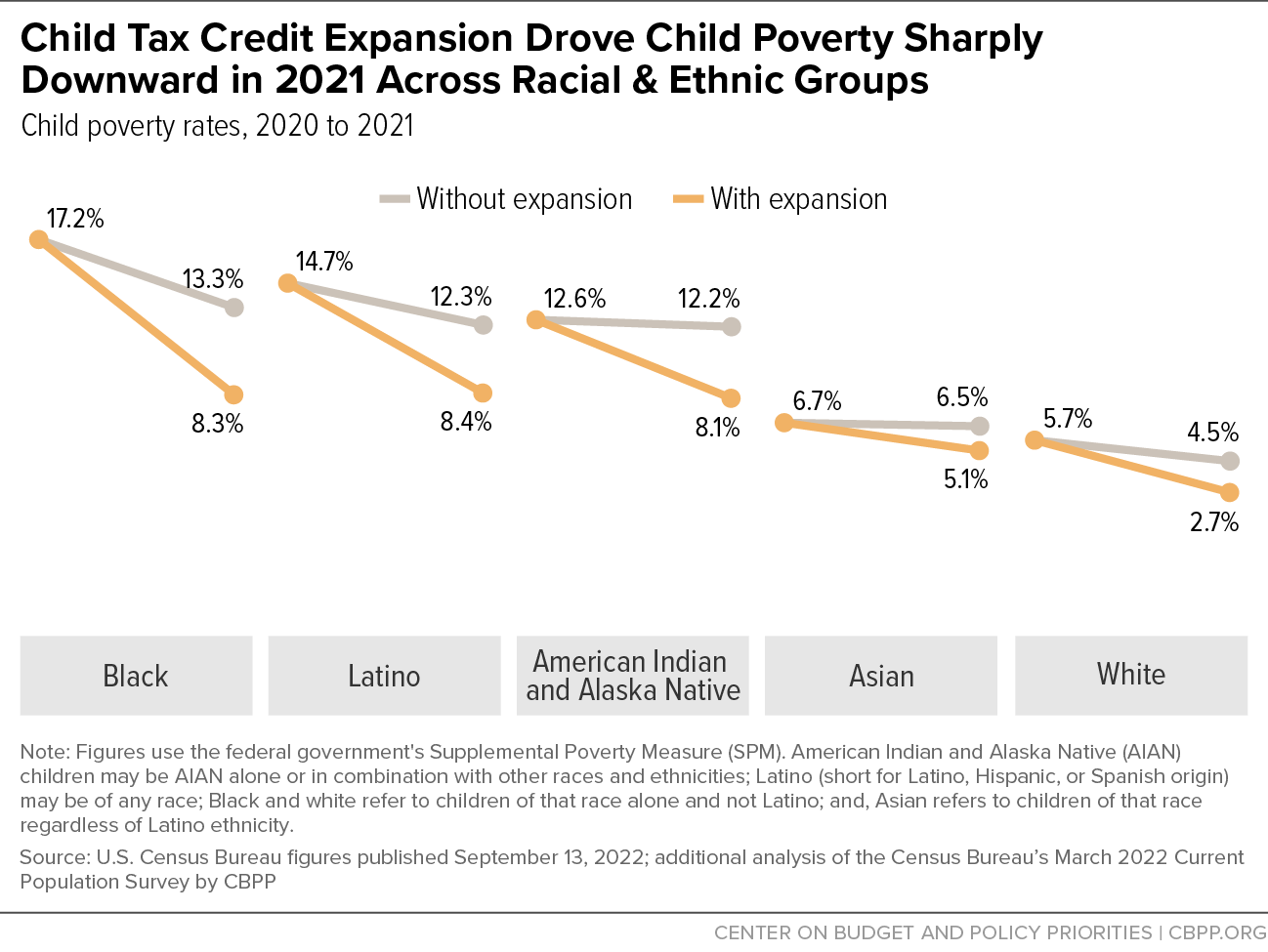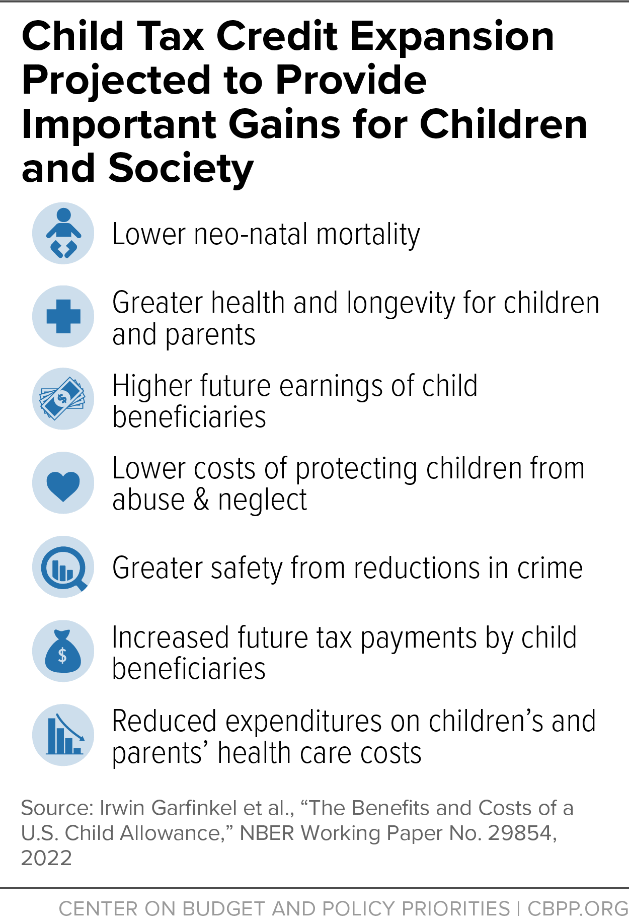Gains From Expanded Child Tax Credit Outweigh Overstated Employment Worries
End Notes
[1] Sharon Parrot, “In Pandemic’s Second Year, Government Policies Helped Drive Child Poverty Rate to a Record Low, Cut Uninsured Rate, New Census Data Show,” CBPP, September 13, 2022, https://www.cbpp.org/press/statements/in-pandemics-second-year-government-policies-helped-drive-child-poverty-rate-to-a.
[2] For instance, Rep. Jason Smith, chair of the House Ways and Means Committee, has cited Bureau of Labor Statistics (BLS) data to argue that the American Rescue Plan’s temporarily expanded Child Tax Credit demonstrated the “disaster of eliminating work requirements.” But the apparent early 2022 uptick in labor force growth that Rep. Smith cites is due to a technical population-size adjustment that BLS makes to the data every January based on updated Census data. Every ten years this adjustment incorporates the latest decennial census results, which generally increases the estimated size of the labor force. As a result, 1.5 million of the published 1.7 million-person increase in the labor force Smith highlights reflects this population-size adjustment rather than a change in actual labor force participation since December 2021. BLS specifically warns users every January about the effects of new population controls in the household survey used to estimate household-based statistics like employment, unemployment, and labor force participation: “Data users are cautioned that these annual population adjustments can affect the comparability of household data series over time.” See Jason Smith, “For America’s economy to work, we need a working-class agenda,” February 9, 2023, https://waysandmeans.house.gov/chairman-smith-op-ed-for-americas-economy-to-work-we-need-a-working-class-agenda/. Lindsey McPherson, “Balanced budget takes back seat to paring spending to ’22 levels at GOP retreat,” Roll Call, March 20, 2023, https://rollcall.com/2023/03/20/balanced-budget-takes-back-seat-to-paring-spending-to-22-levels-at-gop-retreat/. “Employment Situation News Release,” Bureau of Labor Statistics, February 3, 2023, https://www.bls.gov/news.release/archives/empsit_02032023.htm.
[3] Kris Cox et al., “Top Tax Priority: Expanding the Child Tax Credit in Upcoming Economic Legislation,” CBPP, June 7, 2023, https://www.cbpp.org/research/federal-tax/top-tax-priority-expanding-the-child-tax-credit-in-upcoming-economic.
[4] Jack Landry, “The Expanded Child Tax Credit and Parental Employment: Tenuous Evidence Points to Work Disincentives,” Jain Family Institute, February 1, 2022, https://www.jainfamilyinstitute.org/news/the-expanded-child-tax-credit-and-parental-employment-tenuous-evidence-points-to-work-disincentives/.
[5] “The preponderance of empirical evidence suggests that childcare and preschool programs have a positive impact on maternal labor force participation,” Economic Report of the President, March 2023, pp. 204-205, https://www.whitehouse.gov/wp-content/uploads/2023/03/ERP-2023.pdf.
[6]Natasha Pilkauskas et al., “The Effects of Income on the Economic Wellbeing of Families With Low Incomes: Evidence from the 2021 Expanded Child Tax Credit,” National Bureau of Economic Research (NBER) Working Paper 30522, October 2022, https://www.nber.org/system/files/working_papers/w30533/w30533.pdf.
[7] Elizabeth Ananat et al., “Effects of the Expanded Child Tax Credit On Employment Outcomes: Evidence From Real-World Data From April to December 2021,”NBER Working Paper 29823, March 2022, https://www.nber.org/system/files/working_papers/w29823/w29823.pdf; Leah Hamiliton et al., “The impacts of the 2021 expanded child tax credit on family employment nutrition, and financial well-being: Findings from the Social Policy Institute’s Child Tax Credit Panel (Wave 2),” Brookings Institution, https://www.brookings.edu/wp-content/uploads/2022/04/Child-Tax-Credit-Report-Final_Updated.pdf; “Michael Karpman et al., Child Tax Credit Recipients Experienced a Larger Decline in Food Insecurity and a Similar Change in Employment as Nonrecipients Between 2020 and 2021,” Tax Policy Center, May 9, 2022, https://www.taxpolicycenter.org/publications/child-tax-credit-recipients-experienced-larger-decline-food-insecurity-and-similar; Ben Lourie et al., “Effects of the 2021 Expanded Child Tax Credit,” University of California, Irvine, April 4, 2022, https://papers.ssrn.com/sol3/papers.cfm?abstract_id=3990385; Brandon Enriquez et al., “The Short-Term Labor Supply Response to the Expanded Child Tax Credit,” NBER Working Paper 31110, April 2023, https://www.nber.org/system/files/working_papers/w31110/w31110.pdf.
[8] It is unlikely that immediate and sophisticated anticipation and understanding of the new Child Tax Credit legislation among working parents account for trends in employment before the new payments began. Also, unlike several of the other studies of employment in this period, this study includes no regression analysis on employment that controls for demographic and economic factors that could contribute to employment trends. Moreover, the paper cautions, “Because there were many other policy changes that disproportionately affected families with children during this period, it is difficult to determine the extent of the behavioral response to the [advance Child Tax Credit.]” To a degree, this is true of each of the studies on the employment response to the 2021 Child Tax Credit, but research attempting to isolate the role of the credit finds no evidence that it discouraged work. Jeehoon Han, Bruce Meyer, and James Sullivan, “Real-Time Poverty, Material Well-Being, and the Child Tax Credit,” NBER Working Paper 30371, August 2022, https://www.nber.org/system/files/working_papers/w30371/w30371.pdf.
[9] Angela Rachidi, “New Survey Data Raises Questions About the Expanded Child Tax Credit,” American Enterprise Institute, October 18, 2021, https://www.aei.org/poverty-studies/new-survey-data-raises-questions-about-the-expanded-child-tax-credit/.
[10] Center for Law and Social Policy, “Key Findings from National Child Tax Credit Survey: CTC Monthly Payments Are Helping Improve Family Well-Being,” November 2021, https://www.clasp.org/publications/report/brief/key-findings-national-child-tax-credit-survey-ctc-monthly-payments-are/.
[11] This research, as summarized in a February Dallas Fed blog post, is preliminary and suggestive, with a more rigorous paper to follow. Jason Saving and Xiaohan Zhang, “Did the Expanded Child Tax Credit Enable Parents in Financially Vulnerable Households to Work During the Pandemic?” Federal Reserve Bank of Dallas Communities Blog, February 28, 2023, https://www.dallasfed.org/cd/communities/2023/2301#:~:text=Our%20results%20provide%20preliminary%20evidence,hurdles%20to%20labor%20force%20participation.
[12] Megan A. Curran, “Research Roundup of the Expanded Child Tax Credit: One Year On,” Center on Poverty and Social Policy at Columbia University, November 15, 2022, https://static1.squarespace.com/static/610831a16c95260dbd68934a/t/63732dd8efcf0e5c76aea26e/1668492763484/Child-Tax-Credit-Research-Roundup-One-Year-On-CPSP-2022.pdf.
[13] UNICEF and ODI, “Universal child benefits: policy issues and options,” June 2020, https://www.unicef.org/media/70416/file/Universal-child-benefits-Briefing-2020.pdf. The credit in Canada does phase out for families with high incomes.
[14] Employment and Social Development Canada, “Families across Canada will see increase in Canada Child Benefit,” July 20, 2022, https://www.canada.ca/en/employment-social-development/news/2022/07/families-across-canada-will-see-increase-in-canada-child-benefit.html. Canadian dollars are converted to U.S. dollars using the Organisation for Economic Co-operation and Development (OECD) purchasing power parity figures for individual consumption, available at https://www.oecd.org/sdd/prices-ppp/purchasingpowerparitiespppsdata.htm.
[15] Rates are as of May 2023.
[16] These figures come from the OECD’s “short-term labour market statistics” data: https://stats.oecd.org/. Prime-age refers to women aged 25-54. The differences in employment rates among prime-age women between the U.S. and Canada are broadly similar in subsequent years, including 2021, when the expanded Child Tax Credit was in place in the U.S.
[17] Samuel Hammond and Robert Orr, “Report: The Conservative Case for a Child Allowance,” Niskanen Center, February 4, 2021, https://www.niskanencenter.org/report-the-conservative-case-for-a-child-allowance/.
[18] Kourtney Koebel and Tammy Schirle, “The Differential Impact of Universal Child Benefits on the Labour Supply of Married and Single Mothers,” Canadian Public Policy/Analyse de Politiques, 2016, https://doi.org/10.3138/cpp.2015-049; Tammy Schirle, “The effect of universal child benefits on labour supply,” Canadian Journal of Economics/Revue Canadienne d’Economique, 2015, https://www.jstor.org/stable/43818218.
[19] For further evidence from other countries on how income support can help low-income parents work, see Abhijit Banerjee et al., “Does Poverty Change Labor Supply? Evidence from Multiple Income Effects and 115,579 Bags,” NBER Working Paper 27314, June 2020, https://www.nber.org/papers/w27314; Maryke Dessing, “Labor supply, the family and poverty: the S-shaped labor supply curve,” Journal of Economic Behavior & Organization, Vol. 49, No. 4, December 2002, https://www.sciencedirect.com/science/article/abs/pii/S0167268102000112; Diego Vera-Cossio, “Dependence or constraints? Cash transfers and labor supply,” Economic Development and Cultural Change, Vol. 70, No. 4, 2022, https://ideas.repec.org/a/ucp/ecdecc/doi10.1086-714010.html.
[20] Michael Baker, Derek Messacar, and Mark Stabile, “The Effects of Child Tax Benefits on Poverty and Labor Supply: Evidence from the Canada Child Benefit and Universal Child Care Benefit,” NBER Working Paper 28556, March 2021, https://www.nber.org/papers/w28556.
[21] When the amount of a program’s benefits is tied to the amount of earnings, economists call one type of the resulting work incentives “substitution effects.” Canada’s recent credit expansions do not involve substitution effects, while the U.S. elimination of its current Child Tax Credit phase-in would. For a discussion of the work incentive effects of the Child Tax Credit’s phase-in, see Martin Sullivan, “Would the Expanded Child Tax Credit be Bad for the Economy?” Tax Notes, December 12, 2022, https://www.taxnotes.com/tax-notes-today-federal/benefits-and-pensions/would-expanded-child-tax-credit-be-bad-economy/2022/12/12/7ffxq. Sullivan also cites a working paper by Treasury Department economist Kyle Lippold that concludes that because of the phase-in structure, “tax credits promoting employment for low-income workers continue to have strong labor supply effects.” (See Kyle Lippold, “The Effects of the Child Tax Credit on Labor Supply,” U.S. Department of Treasury, November 2019, https://papers.ssrn.com/sol3/papers.cfm?abstract_id=3543751). For a critique of the Lippold study and a thorough examination of the evidence and economics on the Child Tax Credit and employment, see Landry, op. cit..
[22] Note that Canada also has a separate program called the Canada Worker Benefit (CWB), which is conditional on employment. Like the Earned Income Tax Credit (EITC) in the U.S., the CWB is a refundable credit designed to support workers with low incomes. If the U.S. Child Tax Credit became fully refundable, U.S. and Canadian policy would share the broad features of having one credit that is conditional on employment and another (the child benefit) that is not. While there are differences between the U.S. and Canadian economies, populations, and policies, it is notable that Canada has not seen meaningful employment declines under this system.
[23]Garrett Watson and Alex Durante, “Difficult Trade-Offs Make Policy Consensus on Child Tax Credit Elusive,” Tax Foundation, November 10, 2022, https://taxfoundation.org/child-tax-credit-reform/; National Academies of Sciences, Engineering, and Medicine, A Roadmap to Reducing Child Poverty, National Academies Press, 2019, https://www.nap.edu/catalog/25246/a-roadmap-to-reducing-child-poverty; Alex Brill, “Macroeconomics of the Child Tax Credit,” American Enterprise Institute, November 10, 2022, https://www.aei.org/economics/macroeconomics-of-the-child-tax-credit/; Joint Committee on Taxation, “Macroeconomic Analysis of a Permanent Child Tax Credit Expansion,” October 2022, https://waysandmeans.house.gov/wp-content/uploads/2022/11/117-1113.pdf; House Ways and Means Committee GOP, “Tax Scorekeeper Confirms Democrats Partisan Child Tax Credit Policy Costs Taxpayers $1.4 Trillion, Reduces Economic Growth & Removes Workers,” Press Release, November 2, 2022, https://waysandmeans.house.gov/tax-scorekeeper-confirms-democrats-partisan-child-tax-credit-policy-costs-taxpayers-1-4-trillion-reduces-economic-growth-removes-workers/; Jacob Goldin, Elaine Maag, and Katherine Michelmore, “Estimating the Net Fiscal Cost of a Child Tax Credit Expansion,” NBER Working Paper 29342, February 2022, https://www.nber.org/papers/w29342; Jacob Bastian, “How Would a Permanent 2021 Child Tax Credit Affect Poverty and Employment,” Working paper, April 23, 2023, https://drive.google.com/file/d/1H5iNZZO_YFRIDz-3Tip4C-BpnD85bUjH/view; Kevin Corinth et al., “The Anti-Poverty, Targeting, and Labor Supply Effects of the Proposed Child Tax Credit Expansion,” Becker-Friedman Institute Working Paper, October 7, 2021, https://bfi.uchicago.edu/working-paper/2021-115/.
Note: The Tax Foundation and American Enterprise Institute predictions use macroeconomic models and are for full-time equivalent employment. Republican members of the House Ways and Means Committee published a press release stating that, “Based off analysis from the nonpartisan Joint Committee on Taxation (JCT),” the expanded Child Tax Credit would “[s]ideline 300,000 workers”; the JCT report itself estimated a 0.2 percent decline in what it calls effective labor supply, which Ways and Means Republicans translated into the 300,000-person decline in employment. The correct jobs number is likely somewhere higher. The National Academies of Sciences (NAS) Roadmap report omitted substitution effects from its analysis on the grounds that those effects are likely to be small in the context of the U.S. Child Tax Credit expansion; see discussion in Glenn Kessler, “The battle over Biden’s child tax credit and its impact on poverty and workers,” Washington Post, November 8, 2021, https://www.washingtonpost.com/politics/2021/11/08/battle-over-bidens-child-tax-credit-its-impact-poverty-workers/. The NAS report also models a slightly different policy than the Rescue Plan credit. The Rescue Plan had a larger maximum credit amount, $3,6000, for young children than the flat $3,000 policy the NAS modeled.
[24] See Civilian Labor Force Level (series CLF160V) from the Federal Reserve Economic Data, https://fred.stlouisfed.org/series/CLF16OV.
[25]House of Representatives Ways and Means Committee Republicans, “Debunking Democrat Myths About the Child Tax Credit,” December 13, 2021, https://waysandmeans.house.gov/debunking-dems-myths-about-their-child-tax-credit/.
[26] Jacob Bastian, “Predicting the Employment Effects of a Permanent 2020-to-2021 CTC Change: Comparing Bastian (2022), Corinth, Meyer, Stadnicki, and Wu (2021), and Corinth and Meyer (2021),” Rutgers University, November 23, 2022, https://drive.google.com/file/d/1Aa8XfhJEmSHcCRWs2TyK42OrvkQCDJpK/view. An earlier version of Bastian’s study predicted that about 411,000 parents would exit the labor force. His revised range is 354,000-367,000.
[27] This is because the models use labor supply elasticities to summarize how people’s employment decisions respond to changes in the return to work, and the relevant elasticities are drawn in large part from the EITC literature.
[28] Some researchers and commentators also contend that a refundable Child Tax Credit would effectively reverse changes to economic assistance programs in the 1990s (so-called “welfare reform”) and undo subsequent employment gains. See Testimony of Bruce Meyer before the Senate Finance Committee, June 14, 2023, https://www.finance.senate.gov/imo/media/doc/Bruce%20Meyer%20-%20Senate%20Finance%20CTC%20Testimony%201.11.pdf.
But the Child Tax Credit has important design differences from the Aid to Families with Dependent Children (AFDC) program. In that program, as families’ earnings rose from very low levels, cash benefits would fall, often quickly. But a fully refundable Child Tax Credit is a fixed benefit that does not decline as earnings rise (until earnings reach very high levels). People who take work for low or moderate pay, or who increase their work hours, would retain the full credit. In this sense, a refundable Child Tax Credit is meaningfully different from earlier AFDC cash benefits.
1990s experiments on economic assistance programs did show the effectiveness of providing child care assistance and other supports to working families. They also showed the downside of rigid work rules. One negative result of the work rules widely adopted in these programs was an increase in children’s deep poverty rates, documented in numerous pilot projects.
Moreover, today the substantial EITC phase-in remains in place, and continues to add to the incentive to work. Jason Furman, former chair of President Obama’s Council of Economic Advisors, explains that with or without a refundable Child Tax Credit, “The U.S. has and would continue to have among the strongest work incentives for parents of any country in the world. The earned-income tax credit would continue to provide an additional $6,000 for parents of children — but only if they work.” Jason Furman, “Democrats Can Tweak Their Child Allowance to Help Families More,” Wall Street Journal, December 17, 2021, https://www.wsj.com/articles/democrats-can-tweak-their-child-allowance-tax-credit-poverty-build-back-better-inflation-work-requirement-11639772566.
[29] Cox et al., op. cit.
[30] Ibid.
[31]Chuck Marr et al., “Policymakers Should Expand Child Tax Credit in Year-End Legislation to Fight Child Poverty,” CBPP, October 20, 2022, https://www.cbpp.org/research/federal-tax/policymakers-should-expand-child-tax-credit-in-year-end-legislation-to-fight.
[32]Andrew Barr, Jonathan Eggleston, and Alexander A. Smith, “Investing in Infants: the Lasting Effects of Cash Transfers to New Families,” Quarterly Journal of Economics, Vol. 137, No. 4, April 20, 2022, https://doi.org/10.1093/qje/qjac023.
[33] Martha Bailey et al., “Is the Social Safety Net a Long-Term Investment? Large-Scale Evidence from the Food Stamps Program,” Goldman School of Public Policy, April 2020, https://gspp.berkeley.edu/assets/uploads/research/pdf/w26942.pdf ; National Academies of Sciences, op. cit.; Greg Duncan, Pamela Morris, and Chris Rodrigues, “Does Money Really Matter? Estimating Impacts of Family Income on Young Children’s Achievement with Data from Random-Assignment Experiments,” Developmental Psychology, Vol. 47, No. 5, 2011; Chloe N. East, “The Effect of Food Stamps on Children’s Health: Evidence from Immigrants’ Changing Eligibility,” Journal of Human Resources, September 5, 2018; earlier version at http://www.chloeneast.com/uploads/8/9/9/7/8997263/east_jmp.pdf.
[34]Francine Blau and Lawrence Kahn, “Female Labor Supply: Why Is the United States Falling Behind?” American Economic Review, Vol. 103, No. 3, May 2013, https://www.aeaweb.org/articles?id=10.1257/aer.103.3.251.
[35]For reviews of evidence on child care markets and policy in the United States, see Chris Herbst, “Child Care in the United States: Markets, Policy, and Evidence,” IZA DP No. 15547, September 2022, https://www.iza.org/publications/dp/15547/child-care-in-the-united-states-markets-policy-and-evidence; and Economic Report of the President, op. cit. Herbst notes that “a child care subsidy would be expected to increase maternal employment, given that it lowers the fixed costs associated with work, thereby increasing the net (financial) returns to such activity.” Results from a recent randomized controlled trial in Germany show that an intervention increasing the enrollment of lower socioeconomic status families in child care led to a 9 percentage point increase in full-time employment and a 22 percent increase in earnings among mothers. See Henning Hermes et al., “Early Child Care and Labor Supply of Lower-SES Mothers: A Randomized Controlled Trial,” CESifo Working Paper No. 10178, December 2022, https://www.cesifo.org/en/publications/2022/working-paper/early-child-care-and-labor-supply-lower-ses-mothers-randomized.


